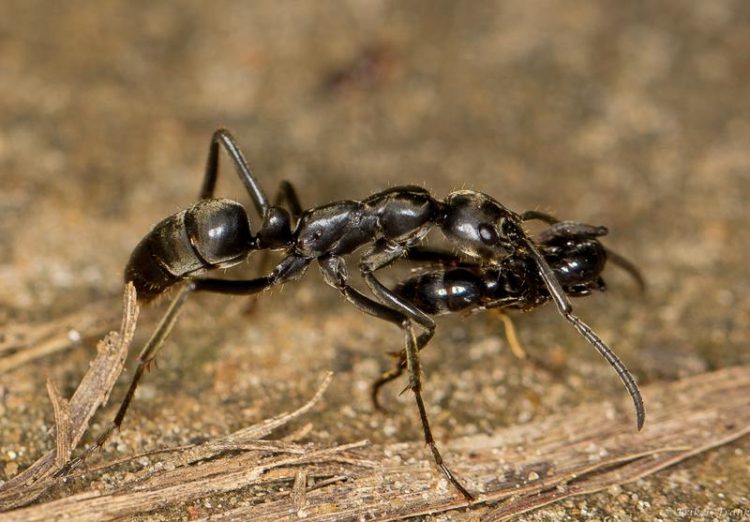Ants rescue their injured

A Matabele ant carries an injured mate back to the nest after a raid. (Photo: Erik Frank)
The African Matabele ants (Megaponera analis) are widespread south of the Sahara and are a specialised termite predator. Two to four times a day, the ants set out to hunt prey. Proceeding in long files, they raid termites at their foraging sites, killing many workers and hauling the prey back to their nest.
These attacks, however, are met with resistance and the ants get involved in fights with termites of the soldier caste. Injury and mortality can occur during such combats, as the soldiers are very adept at using their powerful jaws to fend off the attackers.
So the invasions bear an increased risk of injury. For this reason, the ants have developed a rescue behaviour hitherto unknown in insects.
Chemical signal triggers rescue
When an ant is injured in a fight, it will “call” its mates for help by excreting chemical substances. The injured insect is then carried back to the nest where it can recover after receiving treatment. What is the “therapy” like? Usually, treatment involves removing the termites still clinging to the ant.
A german research team of the University of Würzburg's Biocentre has discovered this rescue behaviour of Megaponera analis and describes it in the journal “Science Advances”. Erik Frank, Thomas Schmitt, Thomas Hovestadt, Oliver Mitesser, Jonas Stiegler, and Karl Eduard Linsenmair, all from the Chair of Animal Ecology and Tropical Biology, have participated in the research.
Rescuing the injured pays off
“We have observed helping behaviour vis-à-vis injured animals for the first time in invertebrates,” says Ph.D. student Erik Frank. This was an unexpected finding, especially for social insects, where individuals are usually of little value. But obviously, it pays off for the colony as a whole to invest in the rescue service as the researchers demonstrate in their publication.
Saving the injured: Rescue behaviour in the termite hunting ant Megaponera analis, Erik T. Frank, Thomas Schmitt, Thomas Hovestadt, Oliver Mitesser, Jonas Stiegler, Karl Eduard Linsenmair, Science Advances, 12. April 2017
Contact
Erik Frank, Biocentre of the Julius-Maximilians-Universität Würzburg (JMU), erik.frank@uni-wuerzburg.de
Information for journalists: Erik Frank will be working at the Ecological Research Station of the University of Würzburg in the Comoé National Park in the Republic of Côte d’Ivoire until July 2017. You can reach him there under the telephone number 0033 970 735 206, via e-mail to erik.frank@uni-wuerzburg.de and via Skype using the name erik_frank
Media Contact
More Information:
http://www.uni-wuerzburg.deAll latest news from the category: Life Sciences and Chemistry
Articles and reports from the Life Sciences and chemistry area deal with applied and basic research into modern biology, chemistry and human medicine.
Valuable information can be found on a range of life sciences fields including bacteriology, biochemistry, bionics, bioinformatics, biophysics, biotechnology, genetics, geobotany, human biology, marine biology, microbiology, molecular biology, cellular biology, zoology, bioinorganic chemistry, microchemistry and environmental chemistry.
Newest articles

Superradiant atoms could push the boundaries of how precisely time can be measured
Superradiant atoms can help us measure time more precisely than ever. In a new study, researchers from the University of Copenhagen present a new method for measuring the time interval,…

Ion thermoelectric conversion devices for near room temperature
The electrode sheet of the thermoelectric device consists of ionic hydrogel, which is sandwiched between the electrodes to form, and the Prussian blue on the electrode undergoes a redox reaction…

Zap Energy achieves 37-million-degree temperatures in a compact device
New publication reports record electron temperatures for a small-scale, sheared-flow-stabilized Z-pinch fusion device. In the nine decades since humans first produced fusion reactions, only a few fusion technologies have demonstrated…





















